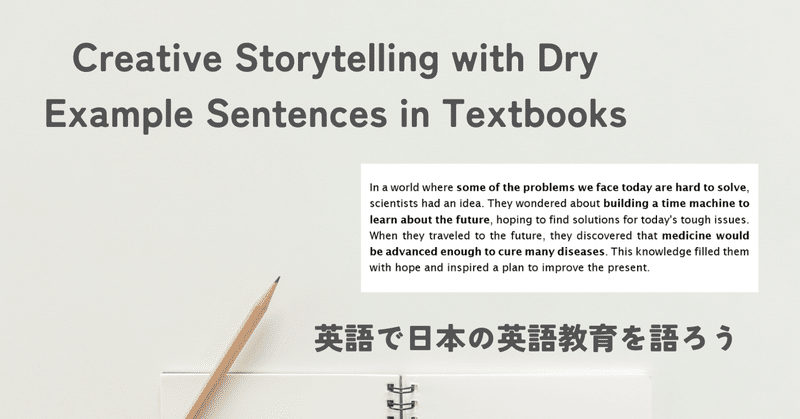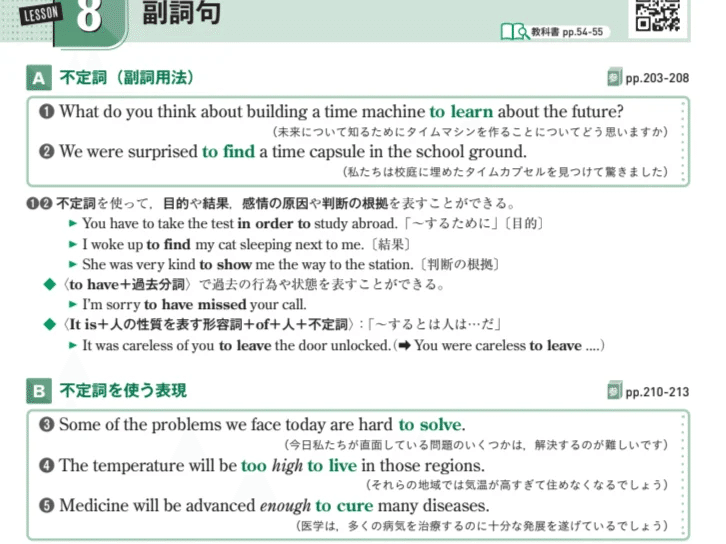
Creative Storytelling with Dry Example Sentences in Textbooks
Many English teachers give grammar explanations using contextually disjointed example sentences in the textbook, leading to dry and uninteresting lessons. Many teach English writing through Japanese-to-English translation exercises but find it hard to move beyond simple translation to more expressive and creative writing. Many of us English teachers probably relate to the challenge of making this transition.
In this post, I propose a solution to this problem: providing context to these dry example sentences and moving beyond basic translation exercises towards more creative writing.
The Challenge of Contextual Learning in English Education
In English lessons in Japanese junior and senior high school, it is common to use example sentences from textbooks or workbooks to explain grammar or to confirm grammatical points through simple Japanese-to-English translation exercises.

However, these example sentences often turn out to be quite bland, and it's challenging to get students to use these grammatical points in context. English teachers frequently struggle to connect these grammar exercises to productive activities like essay writing.
Of course, a proper educational solution to this problem would be to provide tasks with a meaningful context. However, constantly coming up with such tasks is difficult, and it's not always feasible to allocate time for such activities in every lesson.
Creative Storytelling with Example Sentences
Therefore, I introduce a quick activity to practice using targeted grammar items in context.
The instruction is simple:
"Select two or three example sentences from the textbook and create a story by connecting them. You are free to change the order, add sentences before, after, or in between, or slightly modify the example sentences."
For instance, let's suppose you choose the following three sentences from your textbook:
- What do you think about building a time machine to learn about the future?
- Some of the problems we face today are hard to solve.
- Medicine will be advanced to cure many diseases.
Each of these sentences is contextually unrelated, but you can connect them to create a story like this:
In a world where some of the problems we face today are hard to solve, scientists had an idea. They wondered about building a time machine to learn about the future, hoping to find solutions for today's tough issues. When they traveled to the future, they discovered that medicine would be advanced enough to cure many diseases. This knowledge filled them with hope and inspired a plan to improve the present.
In this way, students can try to contextualize the monotonous example sentences with their own creativity.
This activity can be completed in roughly 10 minutes, with perhaps an additional 5 minutes for instructions the first time you introduce it. If you cannot devote class time to this, you can assign it as homework.
You might be surprised at how absorbed students become in this seemingly simple yet intriguing exercise. Sharing their creations in pairs, groups, or with the entire class also adds a fun element to the lesson.
By weaving disconnected sentences into a coherent narrative, they not only practice their grammar but also their storytelling skills. This approach encourages creativity and critical thinking, as students must consider how to logically link different ideas.
Adapting the Activity for Different Skill Levels
To further enhance this activity, there are variations to adjust the difficulty level. If the example sentences in the textbooks have Japanese translations next to them, students tend to think in Japanese, which might limit their English expression. A more challenging and meaningful approach is to conduct this activity without the Japanese translations. You can easily create a simple handout for this purpose by copying and pasting the example sentences without their Japanese counterparts, encouraging students to think directly in English.
On the other hand, if you wish to make the task less challenging, especially for beginners or less confident learners, you can reduce the number of sentences from which students can choose. This simplification helps to focus their creative efforts and makes the task seem less daunting.
Another effective strategy is to encourage brainstorming in groups. This can be particularly beneficial for students who are less confident in their creative skills. Group brainstorming not only sparks creativity but also allows students to learn from each other, as they share ideas and perspectives.
The Importance of Creative English Usage in the AI Era
The sample composition I mentioned earlier, which connected the three example sentences, was actually created by ChatGPT. When I introduced this activity in my lesson, I informed my students that the sample was composed by an AI, ChatGPT. I used this as a motivational tool, encouraging them with the message "Do you best not to fall behind AI."
Mastering grammar rules and producing accurate English is undoubtedly important. However, especially in this era of AI, there's a growing demand for the ability to use accurate English creatively. For this reason, I believe that activities involving creatively utilizing given example sentences within a context are highly effective.
From a teacher's perspective, this activity requires minimal preparation. It's an exercise that can be easily introduced on the spot, making it a practical choice for diverse classroom settings. I encourage my fellow educators to give this method a try if the opportunity arises.
The textbook sample pages and example sentences referenced in this post were borrowed from the Iizuna-shoten website: 論理・表現Ⅰ be Smart/Clear | 株式会社いいずな書店 (iizuna-shoten.com)
この記事が気に入ったらサポートをしてみませんか?
